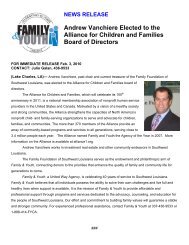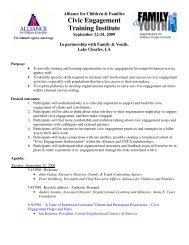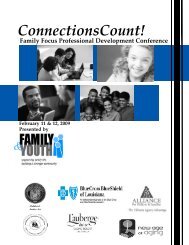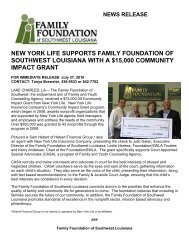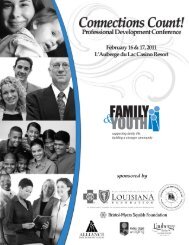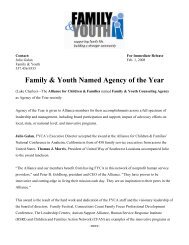Mission-based Advocacy Toolkit from Alliance for Children & Families
Mission-based Advocacy Toolkit from Alliance for Children & Families
Mission-based Advocacy Toolkit from Alliance for Children & Families
You also want an ePaper? Increase the reach of your titles
YUMPU automatically turns print PDFs into web optimized ePapers that Google loves.
Part II: Addressing Common Barriers<br />
BARRIER 5: Limited Board Support <strong>for</strong> <strong>Advocacy</strong><br />
Focus Group participants cited “limited Board support <strong>for</strong> advocacy” as one of the<br />
barriers holding agencies back.<br />
This problem is a common one <strong>for</strong> nonprofit organizations, but those agencies whose<br />
boards have embraced policy advocacy swear by it. Once again, there are some easy,<br />
practical steps that can move agencies in the right direction – especially those new to<br />
policy advocacy.<br />
Easy: Make sure all Board members get copies of the <strong>Alliance</strong> <strong>for</strong> <strong>Children</strong> and<br />
<strong>Families</strong> Magazine articles which describe effective Board involvement in missiondriven<br />
policy advocacy. E.g., the Fall, 2004 issue highlights Lutheran Child and Family<br />
Services of Illinois – which believes pursuing their goals “…couldn’t be accomplished<br />
without impacting the political arena.” As their board – which comes <strong>from</strong> a range of<br />
political perspectives and backgrounds - put it so well, “…if we don’t stand up <strong>for</strong><br />
children and families, who will?” Similarly the <strong>Alliance</strong>’s e-news highlights advocacy<br />
“best practices” on the <strong>Alliance</strong> website. Call attention to both at Board meetings.<br />
Most people understand the concept of “tithing” – the practice of giving one-tenth of<br />
one’s income to a congregation. Suggest that Board members adopt a variant of that<br />
idea, by tithing their own lobbying time. Many board members have already-established<br />
relationships with elected officials and readily approach them on behalf of their own<br />
business or personal interests. Think what it would mean if all the board members of all<br />
of a state’s <strong>Alliance</strong> members used the last fraction (one-tenth or less) of every contact<br />
with elected officials, to put in a good word <strong>for</strong> the agency and the work that it does. It<br />
can be something as simple as saying, “Be<strong>for</strong>e I leave, I just want to remind you that I<br />
wear another hat. When I’m not (a lawyer, a doctor, a member of the Junior League) I sit<br />
on the Board of Family Services. I think they do terrific work, and I hope that when any<br />
of them comes to see you, you’ll hear them out.”<br />
Invite someone <strong>from</strong> your state’s Non-profit Association to make a presentation to the<br />
Board on the legality and importance of policy advocacy by non-profits. Include a board<br />
member <strong>from</strong> a sister agency in another community, one that is actively engaged in<br />
policy advocacy.<br />
Encourage a board discussion of the pro’s and con’s of greater involvement in policy<br />
advocacy.<br />
A bit more challenging: Suggest that your Board develop an advocacy plan just <strong>for</strong> the<br />
Board – one with goals, timelines, and ample opportunities to revise the plan as<br />
circumstances change. Make review of the Board’s advocacy plan a standard part of<br />
every board meeting.<br />
18<br />
© January 2006 The <strong>Alliance</strong> <strong>for</strong> <strong>Children</strong> and <strong>Families</strong>




